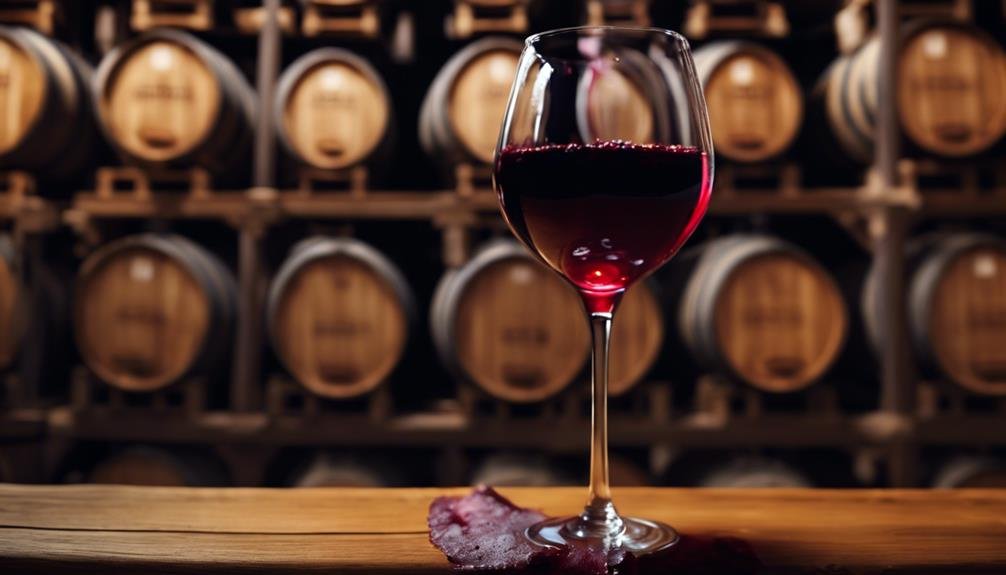Enhance your wine tasting experience by exploring peppery wines like Syrah, which contain the Rotundone compound for a unique flavor. Pair them with dishes like pepper steak to elevate your sensory adventure. Piquant sensations in wines like Chianti Classico complement salty dishes, enhancing the tasting experience. Discover spiced aromas from oak aging, like coconut and vanilla undertones, adding depth and complexity. Learn about identifying pepperiness and exploring diverse red wine styles for a broader palate experience. Embrace the world of spicy wines by understanding flavor compounds and tasting techniques. Uncover a wealth of knowledge to appreciate the nuances of spicy wines.
Peppery Wines and Flavor Enhancements
Pepperiness in wines, characterized by the aroma of freshly crushed black or white pepper, plays a significant role in enhancing flavor profiles and overall tasting experiences. The discovery of Rotundone, a compound found in black peppercorns, contributes to the pepperiness in wines like Syrah. Surprisingly, 1 in 5 people can't perceive this compound.
When it comes to pepperiness perception, pairing these wines with dishes like pepper steak can further elevate the sensory experience. The dynamics of food pairing with peppery wines involve finding complementary flavors that enhance the peppery notes without overpowering them. Understanding the interplay between pepperiness and different food flavors can lead to a more nuanced and enjoyable tasting adventure.
Piquant Sensations and Wine Pairings
In exploring the intricate world of wine tasting experiences, the enticing sensations found in certain wines serve as a captivating avenue for discovering harmonious pairings with various culinary delights. When it comes to piquant sensations and wine pairings, focusing on acidity balance and salty pairings can elevate the tasting experience. Piquant wines like Chianti Classico or Amarone, known for their high acidity, pair exceptionally well with salty or seasoned dishes. The acidity balance in these wines complements the savory saltiness, creating a delightful harmony on the palate. To help visualize the impact of acidity balance and salty pairings, consider the following table:
| Acidity Balance | Salty Pairings |
|---|---|
| High | Cheese Platter |
| Medium | Prosciutto |
| Low | Salted Nuts |
Spiced Aromas From Oak Aging

Enhancing the aromatic profile of wines, oak aging infuses them with a myriad of spiced nuances that contribute to their complexity and depth of flavor. The process of oak aging imparts coconut notes, adding a tropical hint to the wine's aroma.
Vanilla flavors, derived from the vanillin in oak barrels, provide a smooth and sweet undertone to the wine. Additionally, oak lactones present in the aging process give rise to a subtle coconut smell that enhances the overall sensory experience.
Furthermore, the eugenol and guaiacol compounds in oak contribute to spicy toasted aromas, elevating the wine's complexity. These spiced aromas from oak aging create a harmonious blend of flavors that enrich the tasting adventure for wine enthusiasts seeking depth and sophistication.
Enjoying Spicy Red Wines
Exploring the diverse world of red wines, particularly those with spicy characteristics, offers a nuanced and flavorful journey for wine enthusiasts seeking to broaden their palate experiences. Tasting techniques can help identify the pepperiness, piquant, and spiced aromas present in these wines. Food pairings play a vital role in enhancing the sensory experiences of spicy red wines; try pairing pepper-steak with peppery wines, salty dishes with piquant wines, and seasoned dishes with spiced wines to elevate the flavor profiles. Understanding the impact of compounds like Rotundone in Syrah wines, high acidity in Chianti Classico, and spicy aromas from oak aging can deepen your appreciation for these unique characteristics. Embrace the diversity of red wines and explore different styles to find your preferred level of spice.
| Tasting Techniques | Food Pairings |
|---|---|
| Pepperiness | Pepper-Steak |
| Piquant | Salty Dishes |
| Spiced | Seasoned Dishes |
Sources for Spicy Wine Knowledge

Explore reputable literature to deepen your understanding of the scientific principles behind the spiciness present in various wines. By delving into sources that discuss sensory perception and flavor compounds, you can uncover the intricate mechanisms that contribute to the peppery, piquant, and spiced characteristics found in different wine varieties.
Understanding how compounds like rotundone in Syrah wines or eugenol and guaiacol in oak barrels impact flavor perception can enhance your appreciation of spicy wines. Reliable information from sources such as 'The Salty and Burning Taste of Capsaicin' and studies on taste receptors can provide valuable insights into the complexity of spiciness in wines.
Frequently Asked Questions
Can Individuals With Anosmia to Rotundone Still Enjoy Peppery Wines?
Individuals with anosmia to rotundone may still enjoy peppery wines, though they might miss out on the full sensory experience. Rotundone contributes considerably to pepperiness, and its absence could impact their perception of this flavor profile in wines.
How Do TRPV1 Receptors Affect the Perception of Piquant Wines?
TRPV1 receptors play a significant role in taste perception, influencing the sensory experience of piquant wines. These receptors are linked to heat sensation, contributing to the modulation of flavors in high-acid and high-alcohol wines, activating touch receptors over flavor receptors.
What Compounds Contribute to Spicy Aromas in Zinfandel and Pinotage?
Compounds contributing to spicy aromas in Zinfandel and Pinotage include eugenol and guaiacol from oak aging. Zinfandel from Lodi, California, and Pinotage from South Africa offer distinct spicy profiles derived from these compounds, enhancing the sensory perception of these grape varietals.
Are There Specific Regions Known for Producing Extra-Spicy Wines?
Specific regions known for producing extra-spicy wines include Lodi, California for Zinfandel and South Africa for Pinotage. Anosmia, a condition affecting the sense of smell, can impact spice perception. Understanding these nuances enhances wine appreciation.
How Does 4-Vinylguaiacol Enhance the Spiciness of Gewürztraminer Wines?
4-vinylguaiacol, present in Gewürztraminer, enhances spiciness by imparting clove and smoky notes. This compound contributes to the wine's distinct aroma and flavor profile, elevating the sensory experience for enthusiasts seeking a unique tasting adventure.
Conclusion
In the world of wine tasting, the exploration of spice adds a new dimension to the sensory experience. Understanding the compounds that create pepperiness, piquant sensations, and spiced aromas in wines can enhance your appreciation of different varietals.
By delving into the science behind spiciness and embracing diverse flavors, you can elevate your tasting adventure and expand your palate. So, spice up your wine journey and savor the intricate flavors that await you.